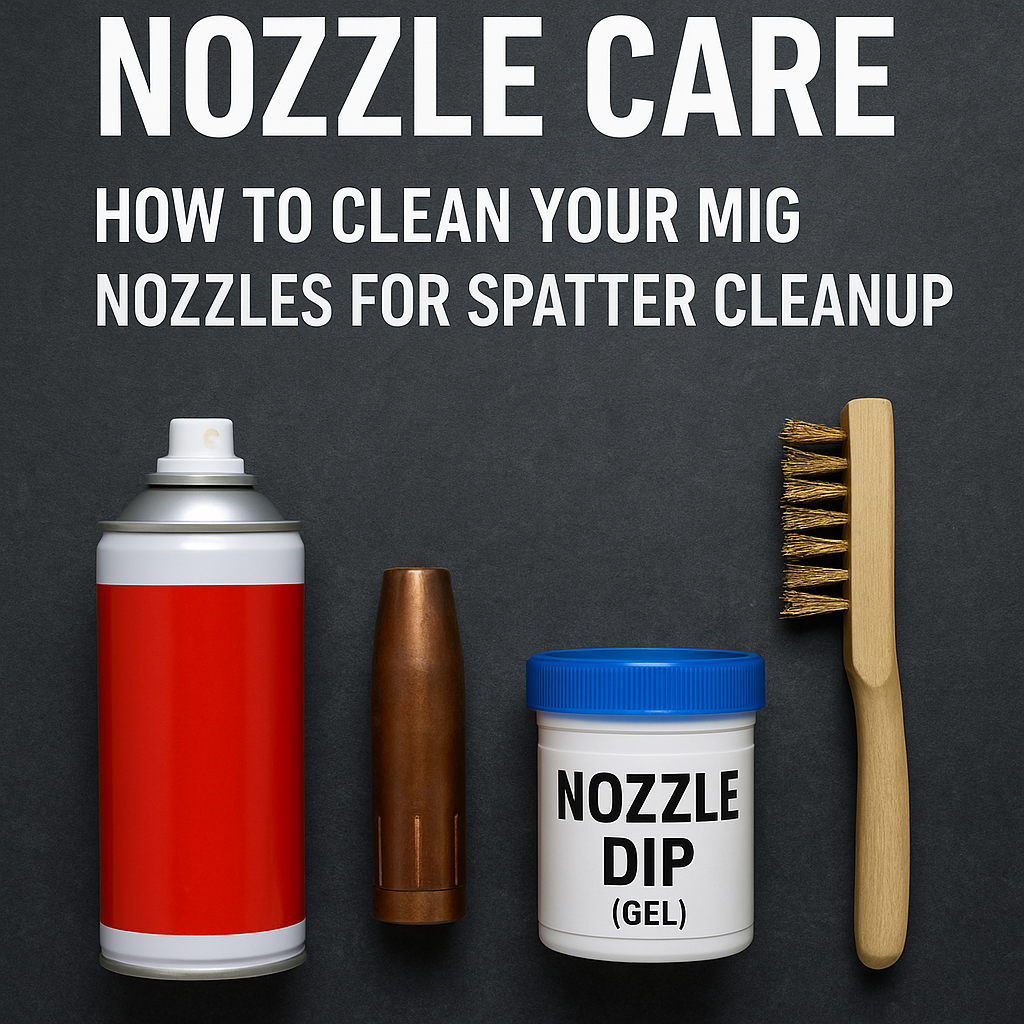MIG welding is known for its efficiency, but even the best welders battle one persistent nuisance—spatter buildup on the nozzle. If left unchecked, spatter clogs gas flow, affects arc stability, and reduces the life of your consumables. That’s why proper nozzle care isn’t optional—it’s essential.
In this post, we’ll walk through how to clean your MIG nozzles, what tools and products help the most, and how to prevent spatter from building up in the first place using anti-spatter spray and nozzle dip. We’ll also touch on the different types of nozzles, including ceramic and standard copper styles, and when to use each. Let’s dive in.
Why Nozzle Maintenance Matters
The nozzle directs shielding gas over your weld, protecting it from contamination. When it gets clogged with spatter, you’ll see erratic arcs, porosity, and weak welds. It also shortens the lifespan of your contact tips and liners, costing you money and time in replacements.
Routine cleaning and prevention extend the life of your equipment, maintain weld quality, and help you avoid unnecessary downtime.
Cleaning MIG Nozzles: Step-by-Step
- Power Off – Always shut off the machine and let everything cool before you start.
- Remove the Nozzle – Unscrew or twist off the nozzle, depending on your model.
- Scrape Out Spatter – Use a nozzle cleaning tool, welper pliers, or a round file to scrape out built-up spatter. Avoid using sharp metal tools that can gouge or warp the nozzle.
- Wire Brush It – Use a small wire brush to finish off the cleaning inside and out.
- Check for Damage – If the nozzle is deformed, cracked, or excessively worn, it’s time to replace it.
- Versatile Design: This mig welding plier serves eight purposes in one, saving you time and boosting productivity
- Durable Construction: Crafted with robust carbon steel, ensuring longevity and reliability
- Ergonomic Grip: The ergonomic handle provides a comfortable and secure grip for extended use
- Multi-Functional: Ideal for hammering, wire cutting, insulation bushing removal, and more
- Easy to Use: The spring-operated handle makes it simple to use and switch between functions
Last update on 2025-12-05 / Affiliate links / Images from Amazon Product Advertising API
Last update on 2025-12-05 / Affiliate links / Images from Amazon Product Advertising API
Preventative Measures: Anti-Spatter Spray & Nozzle Dip
Cleaning helps, but prevention is your best weapon. Here’s how to keep spatter from sticking in the first place:
Anti-Spatter Spray
This silicone-based spray coats your nozzle, contact tip, and even your workpiece to prevent spatter from sticking. Just a light mist before welding helps make post-weld cleanup a breeze.
- When to use: Great for light-duty welding or when you don’t want to disrupt workflow for cleaning.
- Pro tip: Make sure the spray is safe for painted or coated surfaces if you’re using it on the workpiece.
- Category: Welding — Welding Chemicals
Last update on 2025-12-05 / Affiliate links / Images from Amazon Product Advertising API
Nozzle Dip (Gel)
Nozzle dip is a heat-resistant gel that you dip your hot nozzle into. It forms a protective coating that prevents spatter from fusing to the surface.
- When to use: Ideal for production settings or when you’re running high amps and generating more heat/spatter.
- Application tip: Dip only the outer nozzle, not the contact tip.
- Nozzle Gel Petroleum Based Nozzle Gel – 16OZ
- Provides excellent protection against weld spatter build-up on M.I.G. gun nozzles, contact tips
- positioners, stud welding chucks and electrode holders on all automatic
- and semi-automatic welding apparatus
- Will not cause porosity. Blue in color.
Last update on 2025-12-05 / Affiliate links / Images from Amazon Product Advertising API
- Nozzle Gel Petroleum Based Nozzle Gel – 16OZ
- Provides excellent protection against weld spatter build-up on M.I.G. gun nozzles, contact tips
- positioners, stud welding chucks and electrode holders on all automatic
- and semi-automatic welding apparatus
- Will not cause porosity. Blue in color.
Last update on 2025-12-05 / Affiliate links / Images from Amazon Product Advertising API
Different Types of MIG Nozzles
Understanding your nozzle type can affect how you clean and protect it:
- Standard Copper Nozzles: Most common and affordable. Good thermal conductivity, but spatter sticks easily.
- Heavy-Duty Nozzles: Thicker walls and better suited for industrial or high-amperage applications.
- Ceramic Nozzles: Extremely resistant to heat and spatter, but more brittle. Often used in robotic or high-frequency operations.
Choosing the right nozzle for your application—and maintaining it—can make a noticeable difference in your weld quality and machine performance.
Final Thoughts
MIG nozzle maintenance may seem minor, but it plays a major role in keeping your welds clean and your machine running smoothly. Regular cleaning combined with anti-spatter spray or nozzle dip can save you both time and consumables.
Whether you’re a hobbyist or a pro in the shop, having a few of these tools and products in your kit is worth it. And if you’re looking to pick up some of the items mentioned here, we’ve included links to trusted products we recommend. These are affiliate links, so we may earn a small commission—at no extra cost to you—if you decide to buy through them. It helps keep our blog running and supports future content.







Leave a Reply